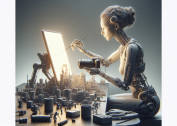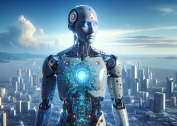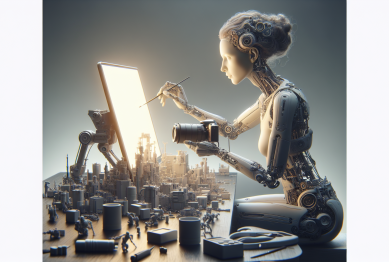Artificial intelligence is transforming the way people approach daily tasks, education, and business. Explore how innovative AI tools are shaping modern life, from language models and chatbots to data analytics platforms, and discover how they impact productivity, creativity, and the way information is accessed.
The Rise of Artificial Intelligence in Everyday Life
Artificial intelligence (AI) is no longer a distant concept reserved for futuristic movies or cutting-edge laboratories. It has woven itself into the fabric of daily existence, quietly powering countless aspects of how information is accessed, processed, and utilized. Many do not realize that when searching for directions, engaging with virtual assistants, or even translating foreign languages, advanced AI technologies are at play. These systems learn, adapt, and often outperform traditional methods of problem-solving, making daily tasks quicker and more reliable. The increased adoption of AI can be traced to growing computing power, improved algorithms, and the abundance of big data—all factors that have driven innovations across tech and science. As digital transformation becomes part of organizational priorities, it’s no surprise that AI tools are now key to efficiency, personalization, and continuous learning. (See: https://www.mit.edu/ai-impact)
The influence of AI stretches beyond typical consumer applications. In the workplace, smart algorithms optimize supply chains, recommend new business strategies, and streamline complex workflows. Educational environments also embrace AI to offer tailored learning experiences, adaptive testing, and automated grading. These developments are not just incremental changes—they represent a paradigm shift. Instead of manually sorting through vast information, AI enables new patterns and insights to emerge. This enhanced analytical capability empowers organizations to make informed decisions and respond to change with agility. Much of this is possible due to advances in natural language processing (NLP) and machine learning, which help machines understand, predict, and interact more naturally with humans. The result is a digital landscape that is more dynamic, interactive, and insightful than ever before.
Yet, as AI becomes more accessible, it also introduces questions about trust and dependence on automated systems. The human-AI partnership is evolving, reshaping the way people solve problems and innovate. Some experts believe that ethical guidelines and transparency are critical, particularly as AI tools take on more autonomous roles. The intersection of convenience, privacy, and responsibility requires thoughtful navigation. While some users embrace AI for its suggestions and support, others express concern about biases coded into the algorithms or the black-box nature of some systems. As these issues are addressed, it is likely that AI’s role in society will continue to expand, unlocking new possibilities for work and learning. (Reference: https://www.technologyreview.com/ai-ethics)
Popular AI Tools Reshaping Productivity
AI-powered productivity software has grown rapidly, supporting both individuals and teams in new ways. Chatbots and virtual assistants—such as Google Assistant and Siri—help organize schedules, answer questions, and automate routine administrative work. Natural language generation tools, powered by sophisticated algorithms, are capable of drafting summaries, writing emails, and even creating articles. For those who manage vast amounts of information daily, such AI-driven programs offer substantial time savings and more consistent outcomes. With AI tools seamlessly integrated into email clients, document editors, and project management platforms, workers find themselves focusing more on creative and strategic thinking, rather than repetitive or low-value tasks. (Reference: https://www.nist.gov/artificial-intelligence)
Another transformative area is data analytics. AI-driven analytics platforms convert raw data into actionable insights, using machine learning to identify trends, outliers, and predictive indicators. These tools are particularly valuable to businesses seeking to optimize operations or forecast shifts in customer demand. Technology such as predictive typing and smart scheduling harness user data to suggest relevant content, prioritize workloads, and even flag potential scheduling conflicts. The democratization of these tools means even small teams or solo entrepreneurs can access enterprise-level insight, thanks to scalable pricing models and cloud-based deployment. Furthermore, the visual nature of many interfaces allows users to quickly interpret results and pivot strategies with confidence.
The convenience of AI-powered automation has also reached sectors like content creation and marketing. Text-generation platforms, image-editing bots, and voice transcription services empower creators to scale their output with consistent quality. By reducing routine mental load, these tools free up space for innovation and deeper analysis. As demand for digital content and data-driven insights grows, so does the appeal of integrating smart automation into everyday workflows. Ultimately, AI tools act as force multipliers, enabling higher productivity and supporting decision-makers with reliable recommendations.
Personalizing Learning With AI-Powered Education
Education technology has leveled up with AI. Intelligent tutoring systems, personalized feedback engines, and custom curriculum generators are changing classrooms across the globe. Adaptive learning platforms use AI to analyze student performance and adjust lessons in real time, meeting individual needs rather than relying on a one-size-fits-all approach. For example, language learning apps often adjust content difficulty based on a learner’s accuracy or pace, enhancing engagement and retention. This approach not only fosters deeper understanding but can also help bridge achievement gaps, particularly for those needing extra support or acceleration. Students now have access to resources tailored precisely to their strengths and improvement areas, promoting lifelong learning. (Source: https://www.ed.gov/technology/ai-in-education)
Assessment and feedback are also evolving with AI. Automated essay-scoring tools, for instance, offer immediate and constructive evaluations, guiding learners in rewriting and refining their work. These systems draw on expansive databases and pattern recognition to ensure consistency and minimize grading fatigue for instructors. Virtual classrooms increasingly use AI to support collaborative projects, peer review, and dynamic content delivery. The result is a more engaging, flexible, and accessible learning environment. Instructors can now devote more time to addressing complex questions or fostering creative discussion, with foundational learning supported by smart automation.
For professional and personal development, online courses leverage AI-driven recommendations to suggest the most relevant materials or learning paths. This curation is informed by a learner’s interaction history, interests, and career goals. As new subjects and skills emerge, access to just-in-time training supported by AI keeps the workforce agile and competitive. Learning management systems now include intelligent dashboards that track progress over time, boosting motivation and reinforcing mastery. Personalized education, powered by advanced algorithms, is creating a future in which every learner has the support and resources needed to succeed, regardless of background or location.
AI’s Impact on Creative Work and Innovation
AI is unlocking new frontiers for creative professionals across industries. Tools using machine learning can generate music, artwork, and even complex code, providing scaffolds for human ingenuity and exploration. For instance, AI-based design software can suggest layouts, color schemes, or even generate entire design drafts from a few prompts. In content creation, generative models help writers refine their craft, brainstorm fresh ideas, and automate tedious parts of production. Rather than replacing artists or coders, AI acts as a collaborative partner—an idea generator, editor, or sparring partner—helping creators reach farther and faster than before. This unique synergy between human imagination and machine learning is reshaping the boundaries of what is possible. (Reference: https://www.nsf.gov/ai-innovation)
Product design, research, and engineering are all being transformed by AI-powered simulation tools and predictive modeling. These platforms help teams prototype, test, and iterate on development projects at unprecedented speed. Whether it’s designing sustainable new materials or optimizing mechanical systems, AI simulation reduces trial-and-error cycles and accelerates the innovation pipeline. Enhanced research capabilities enable scientists and engineers to extract new insights from large and complex data sets, uncovering patterns or relationships that were previously hidden. In practice, these technologies free experts to focus their expertise on high-value activities—like refining concepts, interpreting results, and designing next-generation solutions.
Storytelling is another arena experiencing major changes due to AI. Text and image generators help brands communicate visually, while video synthesis tools bring creative visions to life without extensive technical know-how. The balance between automation and originality remains a central topic, as creators seek ways to safeguard authenticity and uphold creative standards. Despite the rise of AI-generated works, the value of human direction, curation, and ethical guidance remains paramount. As machine and human creativity become increasingly entwined, there is growing potential for collaboration that empowers more diverse voices and brings unexpected ideas to a wider audience.
Data Security and Ethical Challenges in AI Integration
The proliferation of AI tools brings important questions about security, privacy, and trust. Handling massive amounts of personal and organizational data, these systems must adhere to rigorous standards to safeguard sensitive information. Encryption, user consent, and transparent data practices are crucial for building trust and avoiding breaches. Businesses and educators integrating AI are encouraged to adopt frameworks that outline responsible use, risk mitigation, and data governance. Ongoing training for staff and clear communication about how AI decisions are made can reduce the chance of unintended consequences. (Source: https://www.cdt.org/ai-privacy)
Ethical AI requires careful design and continual oversight. Machine learning models are prone to reflecting—and sometimes amplifying—biases present in their training data. Transparent auditing processes, diverse development teams, and ongoing monitoring can help address these concerns. The creation of ethics guidelines, like those outlined by industry leaders and governments, emphasizes the importance of fairness, accountability, and transparency. As more sectors adopt AI, establishing proactive policies will help prevent potential harms, ensuring applications serve the broadest and fairest outcome for all users.
Regulation of AI technologies is an evolving area. Governments and international organizations are working toward clear standards for privacy, explainability, and consent. For users and decision-makers alike, understanding these emerging guidelines can support more confident, informed adoption of AI tools. By staying up to date on data security best practices and advocating for transparent, accountable processes, organizations and individuals can harness the benefits of AI with less risk. Overall, a balanced focus on innovation and responsibility will shape how AI continues to support productivity, learning, and creative work in the future.
Future Horizons: What’s Next for AI and Human Collaboration
Looking ahead, AI is set to become even more embedded in how society operates. From smart cities powered by interconnected systems, to healthcare diagnostics enhanced by medical imaging AI, the possibilities keep growing. Emerging trends point to greater emphasis on explainable AI, where users understand how decisions are made. Human-centered design is coming to the fore, encouraging systems that enhance rather than replace human skill and insight. This shift allows for personalized, adaptive solutions that grow better with continued use. As trust networks evolve around established AI platforms, collaboration and information sharing will accelerate scientific progress and societal benefit. (See: https://www.ibm.com/blogs/watson-health/next-gen-ai)
Interdisciplinary research—combining data science, psychology, social policy, and more—is increasingly important in shaping responsible AI adoption. By integrating diverse perspectives and backgrounds, it becomes possible to anticipate challenges and opportunities earlier in the innovation cycle. Educational programs focused on digital literacy, ethical reasoning, and AI fluency prepare future generations to navigate the changing landscape confidently. For organizations, forging public-private partnerships can broaden access to AI, drive equity, and speed the translation of research to practical application. The most successful use of AI will likely be marked by a healthy blend of technical innovation, continuous learning, and adaptability.
AI’s influence will keep expanding, but human curiosity, judgment, and empathy are irreplaceable. The future is shaped not just by algorithms, but by the choices made about their use, design, and governance. Responsible AI ensures technology supports broader well-being. As innovation continues, collaboration between people and machines will unlock new potential in work, creative pursuits, and scientific discovery. Staying curious and informed will help society maximize these opportunities while minimizing risks, shaping a technology-driven future that benefits all.
References
1. Massachusetts Institute of Technology. (n.d.). The impact of artificial intelligence. Retrieved from https://www.mit.edu/ai-impact
2. MIT Technology Review. (n.d.). Ethics in AI. Retrieved from https://www.technologyreview.com/ai-ethics
3. National Institute of Standards and Technology. (n.d.). Artificial intelligence. Retrieved from https://www.nist.gov/artificial-intelligence
4. U.S. Department of Education. (n.d.). Artificial intelligence in education. Retrieved from https://www.ed.gov/technology/ai-in-education
5. National Science Foundation. (n.d.). Advancing innovation with artificial intelligence. Retrieved from https://www.nsf.gov/ai-innovation
6. Center for Democracy and Technology. (n.d.). AI and privacy. Retrieved from https://www.cdt.org/ai-privacy









